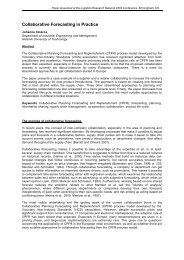Increasing customer value and decreasing distribution costs ... - LRG
Increasing customer value and decreasing distribution costs ... - LRG
Increasing customer value and decreasing distribution costs ... - LRG
Create successful ePaper yourself
Turn your PDF publications into a flip-book with our unique Google optimized e-Paper software.
IJPDLM33,2140The graphs for the two operating models compare the cumulative <strong>costs</strong>. The<strong>costs</strong> are indexed so that 100 represents the total delivery chain <strong>costs</strong> withdirect deliveries. (The same indexing is used also in Figures 2-4.) In the case of atypical MRO order the cost of merging the order lines is lower than the extracost of receiving separate shipments at the <strong>customer</strong> end. From a total supplychain perspective the difference in total <strong>costs</strong> is approximately 13 per cent.A best-case for merge-in-transitIn the ®rst delivery example the order was selected to represent a typical orderfor the MRO distributor. The second example is a best case from the point ofview of merge-in-transit. The suppliers remain the same, but the size of theorder is larger, there are now 41 lines in the order. Also, the <strong>customer</strong> is nowlocated far away from the consolidation point. In this situation consolidationdirectly improves the cost ef®ciency of transportation.The cumulative <strong>distribution</strong> <strong>costs</strong> of the example order are illustrated inFigure 2. The indexing principle is the same as in Figure 1. The index 100represents the total delivery chain <strong>costs</strong> with direct deliveries for the exampleorder.Figure 2.Cumulative deliverychain <strong>costs</strong> of a best-caseorder for merge-in-transit




